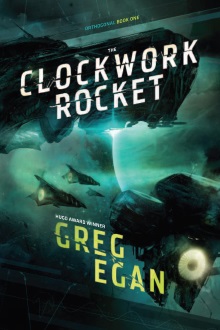
As I’ve mentioned many times, I still consider Greg Egan to be my favorite science-fiction author though his best work was published in the 1990s and some of the latest novels can be quite boring (I’m looking at you Incandescence and Zendegi.) Still, I’m likely to read everything Egan writes eventually and so here we are at The Clockwork Rocket, the first book of the Orthogonal trilogy that was first published in 2011.
If you know anything at all about Egan, you’d know that he just doesn’t do trilogies, so it’s tempting to wonder if he’s finally selling out and producing something that’s more commercially viable. Fortunately the truth is that it’s a trilogy because it needs to be. Egan’s more disappointing novels have tended to be conceptually ambitious but narratively quite small. The Orthogonal trilogy turns out to be breathtakingly epic in scope both in terms of its ideas and its story.
The entire trilogy is set in a universe that is very much not our own. Egan describes the physics that applies in this universe as being Riemannian. You should probably read Egan’s own website for a full treatment of the differences but the upshot is that unlike in our own universe, the dimension of time in the Orthogonal universe obeys exactly the same rules as those of space. The science part of this trilogy explores the ramifications of how this small change reverberates across all of the physics of this alternate universe. Some of the strangest results include the fact that not only does light not travel at a fixed speed but that different wavelengths of light travel at different speeds and an object that emits light actually generates energy.
It stands to reason that the beings who inhabit this strange universe are even stranger, though I won’t spoil the slow and enjoyable sense of discovery as you slowly realize just how weird they are. In any case, the protagonist here is Yalda, a curious but uneducated farm-girl from a backwards part of her planet. When her father realizes how smart she is, he respects the wishes of her long-dead mother and sends her to school. There she (along with the reader) not only learns more about her world, but eventually becomes one of its preeminent physicists, being the first to discover the peculiar properties of time as described above.
The epic scope of the story becomes evident when Yalda, along with other scientists, realize that the Hurtlers, a phenomenon that they perceive in the sky that somewhat resemble meteors, constitute an existential threat to their entire planet. The only plan that they can come up with is so audacious that it feels like something out of the Golden Age of science-fiction: blast a whole mountain into the sky at such a high speed that it becomes a generation starship. Due to the particular physics of their universe, their version of time dilation allows anything that travels fast enough to become orthogonal to their usual arrow of time, such that however long time passes on the ship, no time would have passed on the original homeworld. The idea is that the volunteers on the ship would have untold numbers of generations to work on the science needed to save the homeworld and return only when they have a feasible plan.
As amazing as all this is, I found my favorite part of this first book is how Egan sets up the biology of this alien species such that the sexual and political dynamics involved have eerie parallels to our own and yet is undeniably unique. Again, without giving much away, this is a species for whom having sex is literally murder and in which the females are physically dominant but socially inferior. I also really enjoyed how the opening for this novel is markedly different from Egan’s usual style. No technobabble, no exposition. Instead, it starts with a journey into the forest from a child’s point of view, while the adults recount a scary children’s story. This is probably one of rare Egan novels in which I actually found myself caring for the characters themselves. I longed for a scene of an adult Yalda returning home to see her father and was sorely disappointed that no such scene was forthcoming.
Still, I confess that I’m not quite smart enough to follow along with all of the physics and Egan himself also confesses in the afterword that not everything is perfectly rigorous. But I’m curious enough about this thought experiment to be willing to take Egan for his word when it gets too deep for me. If this doesn’t hold your interest, then it’s doubtful that this novel would hold any value to you, however amazing the story is. To me, however this is a return to form and some of the best science-fiction I’ve ever read. I eagerly look forward to reading the rest of the trilogy.
One thought on “The Clockwork Rocket”